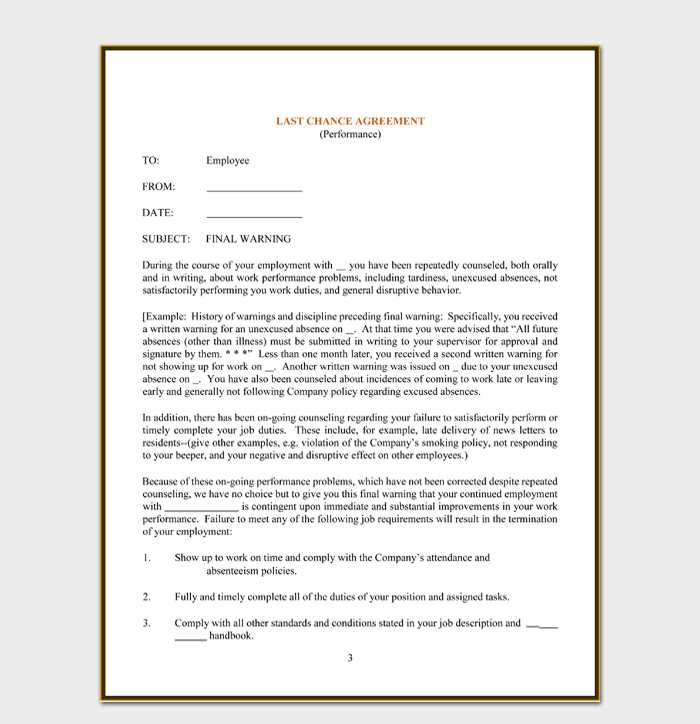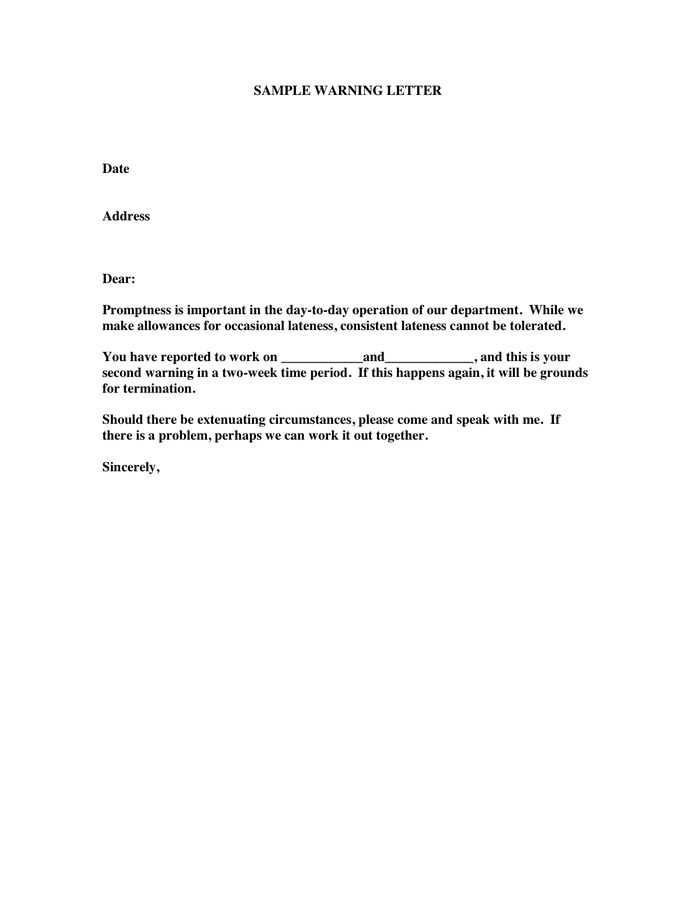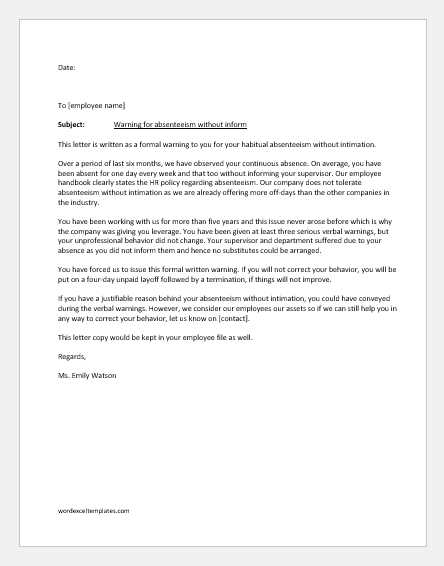Warning Letter Template for Addressing Employee Absenteeism

Managing employee presence is crucial for maintaining a productive work environment. When an individual frequently fails to show up without valid reasons, it can disrupt workflows and impact team morale. It is essential for employers to handle such situations with care and professionalism.
One of the most effective ways to address frequent absences is through clear communication. When an employee’s attendance becomes a concern, notifying them in writing can clarify expectations and establish the consequences of continued non-compliance. A formal document serves not only as a record but also as a tool for encouraging improvement.
Crafting an appropriate notice involves balancing firmness with understanding. Employers must express the seriousness of the issue while offering the employee a chance to explain or correct their behavior. Such documents often follow a standard structure, ensuring that all necessary points are covered clearly and fairly.
Understanding the Importance of Warning Letters
Effective communication is vital in the workplace, especially when it comes to addressing performance issues. When an employee’s actions, such as frequent absence, negatively impact the team or business operations, it’s crucial to address the matter promptly. A formal document plays an essential role in conveying the severity of the situation while maintaining professionalism.
By issuing a formal notification, employers not only inform the individual of their concerns but also provide a documented record of the interaction. This serves as evidence should the matter escalate and may be useful in the future, should further disciplinary action be required. The document helps clarify expectations and consequences, offering the employee a chance to improve their behavior.
Using a formal approach ensures consistency and fairness across all situations. It provides a structured way to address issues, ensuring all necessary points are covered and reducing the risk of misunderstanding. A carefully worded communication fosters an opportunity for resolution while emphasizing the importance of adherence to company policies.
How to Address Employee Absenteeism Effectively
Dealing with inconsistent employee presence requires a proactive and structured approach. When an individual repeatedly fails to attend work without valid reasons, it’s essential to act swiftly and professionally to prevent further disruption to the team. The first step is recognizing the importance of clear communication and setting clear expectations regarding attendance.
It is crucial to approach the situation with both firmness and fairness. The goal is not only to inform the employee of the impact their behavior has on the team but also to provide them an opportunity to explain the reasons behind their absences. In many cases, understanding underlying causes can lead to finding a solution that benefits both the employee and the organization.
Documenting these discussions is an important step in addressing attendance concerns. By keeping a written record of the conversation, the employer ensures transparency and consistency. This process should also involve outlining potential consequences if the behavior continues, reinforcing the seriousness of the issue while offering a clear path to resolution.
Steps to Create a Warning Letter
Addressing attendance issues requires careful consideration and a structured approach. To ensure clarity and fairness, employers should follow specific steps when communicating concerns to an employee. Crafting a well-written notice involves several key stages that not only address the problem but also allow for resolution.
Gather Relevant Information
The first step in creating a formal notice is gathering all relevant information. This includes reviewing the employee’s attendance record and identifying patterns of absence. It’s important to ensure that the facts are accurate and complete before proceeding to the next step. This helps avoid misunderstandings and shows the employee that the issue has been carefully considered.
Craft Clear and Professional Communication

Once the facts are collected, the next step is to clearly communicate the issue in writing. The tone should remain professional and neutral, focusing on the behavior rather than the individual. The document should explain the impact of the absences on the team and the company, outline expectations moving forward, and provide a chance for the employee to explain their situation.
It’s essential to include any next steps or consequences if the behavior continues, while also offering support if there are underlying issues that may be addressed. Providing clear instructions on what the employee can do to improve will help guide them toward corrective actions.
Key Elements in a Warning Letter Template
When addressing attendance issues, a clear and structured approach ensures that all important points are communicated effectively. A formal written notice should include specific elements to make sure the message is both clear and professional. These elements not only highlight the problem but also lay out the expectations moving forward.
Essential Components

There are several key components to include when creating a written notice. These sections will help ensure that the message is comprehensive and that both the employer and employee have a clear understanding of the issue.
- Employee Information: Include the employee’s name, position, and department for clarity.
- Details of the Issue: Clearly state the attendance problem, including dates or periods of absence.
- Impact on the Team: Explain how the absences affect productivity and team morale.
- Expected Behavior: Outline the company’s attendance expectations and any specific improvements required.
- Consequences: Mention potential actions if the situation doesn’t improve, such as further disciplinary measures.
- Next Steps: Provide a clear plan for the employee to follow to address the issue, such as a meeting or follow-up date.
Tone and Clarity
Maintaining a professional, neutral tone is crucial when crafting the notice. The document should focus on addressing the behavior rather than making personal attacks. Clear, concise language ensures there is no confusion about the expectations and consequences outlined in the message.
Legal Considerations in Employee Absenteeism
When addressing frequent employee absence, it’s essential to be aware of the legal framework surrounding workplace attendance. Employers must balance enforcing company policies with adhering to labor laws that protect employees’ rights. Taking the wrong approach can lead to legal complications, including claims of unfair treatment or wrongful termination.
Employers should be familiar with various laws and regulations that govern issues such as paid leave, medical leave, and discrimination. Additionally, understanding the company’s contractual obligations and internal policies will help ensure any action taken is legally compliant. Below is a table outlining some key legal aspects employers need to consider:
| Legal Aspect | Description |
|---|---|
| Labor Laws | Ensure adherence to local or national labor regulations regarding paid and unpaid leave. |
| Medical Leave | Understand employees’ rights to medical or disability leave under laws like the FMLA (Family and Medical Leave Act). |
| Discrimination | Avoid discrimination based on protected characteristics such as race, gender, or disability when addressing attendance issues. |
| Contractual Obligations | Review employment contracts to ensure any actions taken align with agreed terms and conditions. |
| Record Keeping | Maintain accurate documentation of absences and any corrective actions taken to support fair decision-making. |
By being aware of these legal considerations, employers can minimize risks and ensure they are treating employees fairly and within the law. This helps in maintaining a positive work environment while addressing attendance concerns appropriately.
Best Practices for Managing Attendance Issues
Effectively managing employee attendance is essential for maintaining a productive and harmonious workplace. Implementing clear policies and practices that address both the causes and consequences of absenteeism can help ensure that all employees adhere to expectations. A structured approach benefits both the organization and the individuals involved, fostering a fair and transparent environment.
One of the most important practices is to establish clear attendance policies. By defining what is considered acceptable attendance, along with the procedures for requesting leave or reporting absences, employees know exactly what is expected of them. This helps avoid confusion and ensures consistency in how attendance issues are handled.
Another best practice is to maintain open communication with employees. Addressing attendance problems early and discussing any underlying causes–whether personal or health-related–helps build trust. Providing support or flexibility, when appropriate, shows employees that the company values their well-being and is willing to accommodate genuine needs.
Documenting absences is also crucial for transparency. Keeping accurate records of each instance of absence allows employers to spot patterns and address chronic issues proactively. These records serve as evidence if further action is needed and ensure fairness in how different cases are treated.
Finally, follow up consistently. Regular check-ins after addressing attendance concerns can help reinforce expectations and provide an opportunity to discuss any improvements or continued issues. This ongoing feedback loop demonstrates commitment to resolving the issue and supporting the employee’s growth within the company.